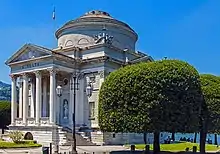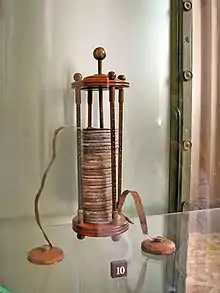Tempio Voltiano
The Tempio Voltiano (Italian; Volta Temple in English) is a museum in the city of Como, Italy that is dedicated to Alessandro Volta, a prolific scientist and the inventor of the electrical battery. Volta was born in Como in 1745, held his first professorship there until 1779, and retired to Como in 1819.

The neoclassical building was designed by Federico Frigerio (1873–1959). It was completed in 1927 to celebrate the 100th anniversary of the scientist's death, but it was inaugurated only in 1928. It hosts a collection of scientific instruments used by the physicist including his early voltaic piles (batteries). The first floor has a display of his personal belongings and his awards.
It is one of the most visited museums in town. The temple was featured on the back of the 10,000 lire banknote, while Volta's portrait was depicted on the front of the same banknote. Banknotes based on the Italian lira have since been replaced by notes denominated in Euros.
Near the Tempio Voltiano are the new statue by Daniel Libeskind named Life Electric and the Faro Voltiano. both dedicated to Volta.
 A voltaic pile on display in the Tempio Voltiano.
A voltaic pile on display in the Tempio Voltiano..JPG.webp) The temple was featured on the 10,000 lire banknote (1984–2001).
The temple was featured on the 10,000 lire banknote (1984–2001).
References
| Wikimedia Commons has media related to Tempio voltiano (Como). |
- "Musei Civici di Como - Tempio Voltiano" (in Italian). Retrieved 2012-11-20.
Further reading
- Graham-Cumming, John (2009). "Tempio Voltiano, Como, Italy". The Geek Atlas: 128 Places Where Science and Technology Come Alive. O'Reilly Media. p. 95. ISBN 9780596523206.
